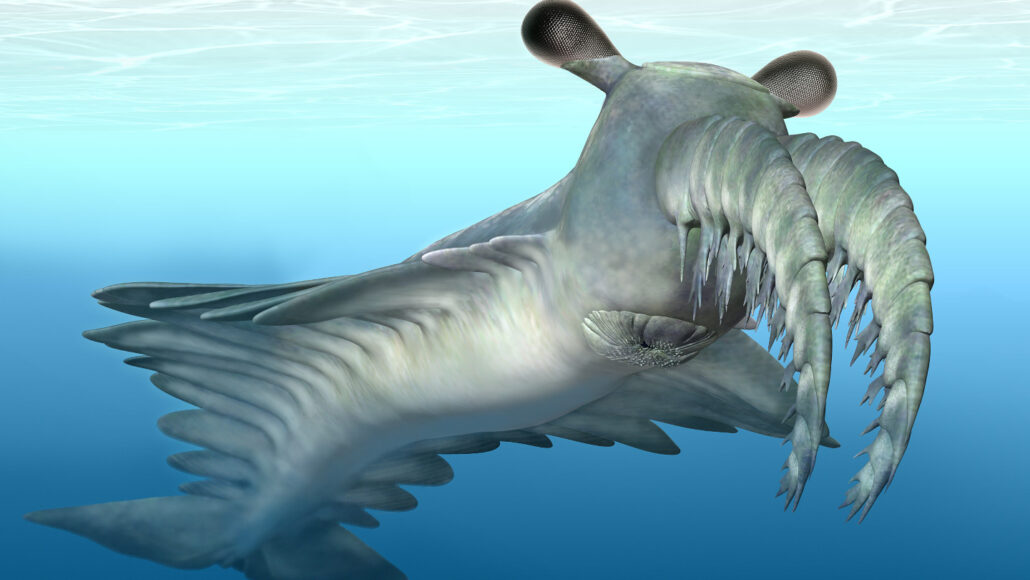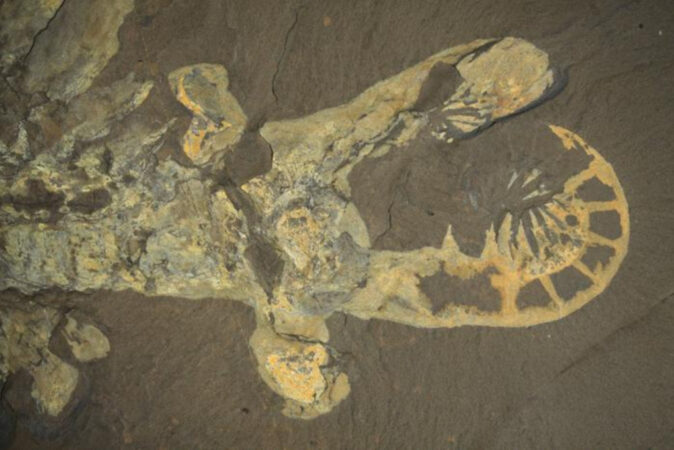This bizarre ancient predator snagged soft prey
Scientists are rethinking how this creature used the limbs sticking out of its face to hunt

Anomalocaris canadensis (illustrated) was one of the earliest known top predators. It hunted in the water around a half billion years ago.
Katrina Kenny
By Nikk Ogasa
This ancient predator had two spiny appendages sticking out of its face. This creature — Anomalocaris canadensis — may have been the freakiest thing to ever haunt the sea. For decades, scientists thought it used those strange limbs to snatch trilobites off the seafloor. The beast could then crush and eat these crunchy snacks. But a new study hints that A. canadensis instead used its spiny limbs to swiftly hunt soft prey.
Researchers shared their new findings on July 12. The work appeared in Proceedings of the Royal Society B.
A. canadensis means “the abnormal shrimp from Canada.” It prowled the seas roughly 500 million years ago. Only about as long as a housecat, it still was one of the biggest animals of the Cambrian Period. (The Cambrian ran from about 540 million to 485 million years ago.) That makes A. canadensis one of the earliest top predators.
These sea monsters were like the orcas or great white sharks of their time, says Jakob Vinther. He did not take part in the new study. But he is a paleontologist at the University of Bristol in England.
Some researchers thought A. canadensis hunted another iconic Cambrian critter — the trilobite. That’s because people have unearthed lots of fossils of injured trilobites. This hinted that something had attacked them. A. canadensis became a prime suspect.
But Russell Bicknell wasn’t so sure. After all, trilobites have hard, thick exoskeletons. And no one had shown that A. canadensis could crack that armor.
Bicknell is a paleobiologist. He works at the American Museum of Natural History in New York City. He was part of a team that set out to learn if A. canadensis really could have crushed and chowed down on trilobites.

Pinning softies with its spikes
The researchers compared the ancient creature’s bendy appendages to those of modern arthropods. These animals include today’s insects, spiders and crustaceans. Bicknell’s team also built computer models of the limbs on A. canadensis. Using those models, the team tested the limbs’ toughness, range of motion and best swimming position.
The ancient spiky limbs would have been good at grabbing prey. In that way, A. canadensis may have hunted much like today’s whip spiders. But the limbs of A. canadensis probably were too fragile to attack armored prey. Those would have included trilobites.
Plus, A. canadensis would have moved most efficiently when its appendages were stretched out front. (Think of how Superman holds his arms while in flight.)
Together, these results suggest that A. canadensis was best suited for chasing soft creatures swimming through the water. It would have snagged prey in its spiky clutches, Bicknell says. It was “going to absolutely pincushion something soft and squishy.”







